Pollo AI: Free All-in-One AI Image and Video Generator
Pollo AI: Free All-in-One AI Image and Video Generator
Pony Diffusion is a versatile text-to-image diffusion model designed to generate high-quality, non-photorealistic images across various styles, enhancing creativity and artistic expression.


A young woman with fiery red hair stands in a field of flowers

Two adorable pony girls, sharing an apple, warm and fuzzy

A cool and confident pony princess in a bikini, with a robotic arm, adjusting her sunglasses, under a bright blue sky

A proud Orc warrior, in full plate armor, staring intensely at front

A cute mouse girl in a purple dress, reaching out to bubbles, playful and joyful

Unicorn wears jacket talks phone snowy cityscape buildings
1. Text-to-Image Generation
Pony Diffusion is a latent text-to-image diffusion model that generates high-quality images based on textual descriptions, specifically designed for creating pony-themed artwork.
2. Fine-Tuned Model
The model has been fine-tuned on a dataset of approximately 80,000 pony images, ensuring that it produces relevant and aesthetically pleasing outputs.
3. User-Friendly Interface
Pony Diffusion offers an easy-to-use interface that allows users to generate images simply by entering text prompts, making it accessible for users with various levels of expertise.
4. Community Engagement
The model encourages community involvement through discussions, feedback, and collaboration, fostering a supportive environment for users to share their creations and improvements.
5. Open Access License
Pony Diffusion is available under a CreativeML OpenRAIL license, allowing users to freely use, redistribute, and modify the model while adhering to specific guidelines.
Pony Diffusion is a latent text-to-image diffusion model that generates images based on descriptive text prompts, allowing users to create detailed and imaginative visuals.
The model is fine-tuned on a large dataset of high-quality pony images, specifically selected for SFW content, which enhances its ability to produce aesthetically pleasing images.
Pony Diffusion employs CLIP-based aesthetic ranking to evaluate and select images during training, helping the model learn what constitutes 'good' visual quality.
The model utilizes a scoring system, such as 'score_9', to categorize images based on quality, allowing users to specify desired output quality in prompts.
1. Step 1: Create Your Prompt
Write a descriptive prompt for the image you want to generate. Be specific about the details and style you desire to guide the model effectively.
2. Step 2: Generate the Image
Run the model with your prompt. After a short processing time, the generated image will be available for you to view and download.
3. Step 3: Save Your Work
Once you're satisfied with the generated image, save it to your device. You can also share it with others or use it as you wish.